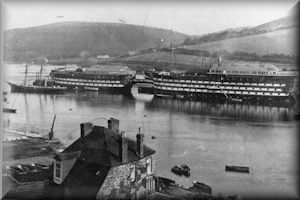Britannia Royal Naval College Dartmouth

Six ships and a shore establishment of the Royal Navy have borne
the name HMS Britannia, after Britannia, the goddess and personification of
Great Britain. It was the name given for the preliminary education of naval
officers from 1859 to 1905. It was anchored first at Portsmouth, then Portland,
and finally off the town of Dartmouth in Devon. The first ship used was the
1820 three-decker Britannia, which was replaced in 1869 by the three-decker
Prince of Wales, which became the fifth ship to bear the name Britannia. From
1864 onwards the two-decker Hindostan was moored ahead of Britannia and
connected by an enclosed gangway, providing extra accommodation and classroom
space.
Cadets joining the Royal Navy were entered into a "term" in
Britannia, which they remained in for two years. There were a varying number of
terms entered each year, ranging from two to four before normalising at three
per annum. If cadets gained enough time through scholarly aptitude and good
behaviour, upon leaving for the fleet they were rated Midshipmen; if not then
they left as Naval Cadets and had to pass further examinations to become
Midshipmen. Over the forty-six year life of Britannia, the training and
education changed continually, with seamanship and mathematics being the only
constants. In 1880, according to Professor Soley, Naval Cadets received
twenty-eight hours of instruction a week, divided between three hours in the
morning, and two and a half hours in the afternoon excepting Wednesdays and
Saturdays. One hour every evening except Saturday was devoted to evening study,
and for the upper two terms half an hour's study before breakfast.
In
1895 the Board of Admiralty began to seriously discuss the construction of a
new shore-based training school for naval officers. After much legal wrangling
over the purchase of the required land, tenders were issued for construction of
a new college by Aston Webb in 1900 and construction began. In 1902 the
so-called Selborne Scheme was promulgated, which would institute common
training for all officer entrants regardless of which branch or service they
wished to join. Only upon reaching the rank of Sub-Lieutenant could an officer
join the Engineer Branch or the Royal Marines. Because the new naval college
was not yet ready, and would require modifications, it was decided to build a
new college in the grounds of Osborne Palace on the Isle of Wight at which
Naval Cadets would spend their first six terms (two years), and then progress
to the college at Dartmouth for another two years of study. Construction at
Osborne began in March, 1903, and the first term of the new scheme was admitted
in September.
It was decided that the new college at Dartmouth would not
be opened until the first term from Osborne could occupy it. Captain Cross of
Britannia [not unnaturally] assumed that he and his staff would transfer to the
new Royal Naval College with the terms currently under training. The Commanding
Officer of Osborne, Captain Rosslyn Wemyss, and the new Director of Naval
Education, Sir Alfred James Ewing, KCB, FRS, MInstCE both agreed however that
there could be no mixing of the cadets of the old and new schemes, with the
latter writing, "I am very anxious to see that Dartmouth College develops on
entirely new lines without Britannia interference or even
influence."
The Royal Naval College, Osborne, located in the grounds of
Osborne House on the Isle of Wight, served as the junior training establishment
for the training of naval cadets of the Military Branch of the Royal Navy from
1903 to 1921. Cadets spent two years under study there before transferring for
two years' further study at the Royal Naval College, Dartmouth. The Service
Records of Royal Navy personnel educated under this new scheme bear the
unromantic entry of "Training Establishment" in lieu of their predecessors,
whose records indicate, appoints to Britannia, training ship.
The Royal
Naval College, Dartmouth, or Britannia Royal Naval College, was opened in 1905
as the senior training establishment for naval cadets of the Military Branch of
the Royal Navy. Cadets were educated there for two years after two years at the
junior training establishment, Royal Naval College, Osborne. After Osborne's
closure in 1921 all early entry naval cadets were trained at Dartmouth.
Officers continue to be trained there today in its guise as Britannia Royal
Naval College. |
